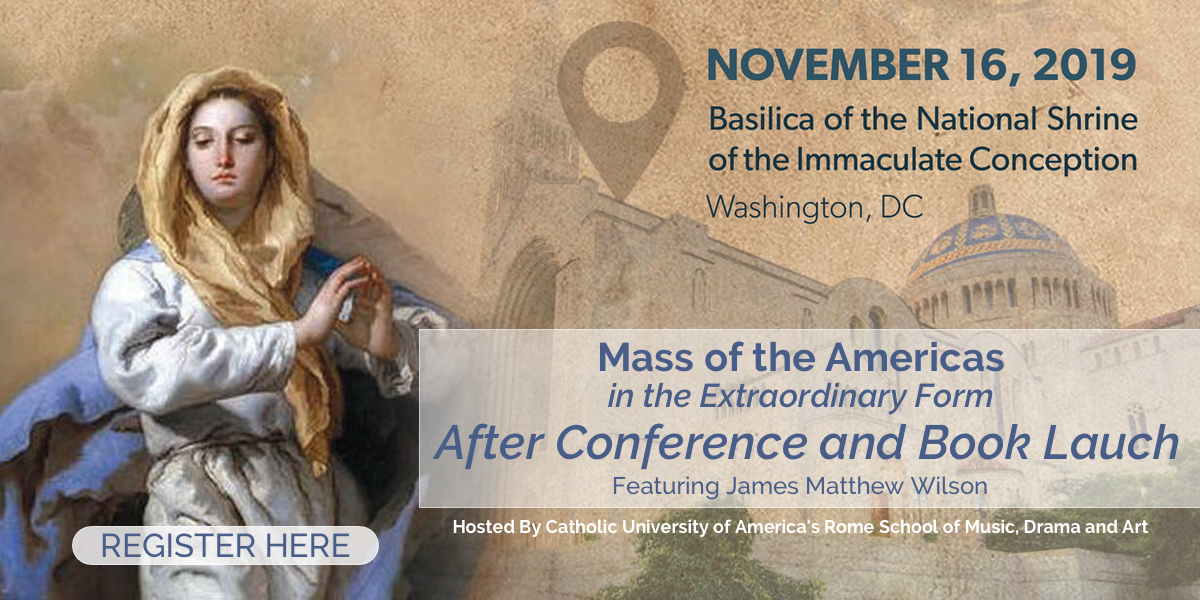I was privileged to have a front row seat for the Mass of the Americas in Washington last Saturday. Wow! What a fantastic experience!
The Mass of the Americas is a production of the Benedict XVI Institute in San Francisco. The Mass on Saturday is the brainchild of Archbishop Cordileone. In the round table seminar after the Mass the Archbishop explained that for most of his life he had worked in California with Hispanic communities and he appreciated their folk religion Catholic customs and devotion to Our Lady of Guadalupe. It also hit him that the Feast of Our Lady of Guadalupe and the Solemnity of the Immaculate Conception occur in the church calendar within a few days of each other. The United States is dedicated to the Immaculate Conception and Our Lady of Guadalupe is the patroness of the Americas. Why not commission a Mass setting which brings all these things together?
The composer, Frank LaRocca, took up the challenge and melded together the tunes from Mexican devotional hymns to the Blessed Mother with traditional Catholic liturgical music–polyphony and chant and delivered a stunning composition that echoed the haunting contemporary music of Avro Part.
The music was originally composed for the Ordinary Form of the Mass, but when the Archbishop was invited to celebrate the Extraordinary Form at the National Basilica he asked LaRocca to re work the music to be suitable for a celebration of the Extraordinary Form. The result was a wonderful combination of traditional liturgy, contemporary liturgical music, traditional forms and simple folk tunes. In the seminar after the Mass one commenter observed that this Mass actually displayed in a perfectly Catholic way all that had been discussed about inculturation at the Amazon Synod the month before.
The languages used on the day were English, Spanish, Latin and Aztec. The building was the National Basilica in the nation’s capital–the liturgy at once traditional and contemporary. This was the blend of cultures that true Catholic worship can bring about. The development of the Mass–first written for the Ordinary Form and then used for the Extraordinary Form showed the proper inter-relatedness of the two forms–each influencing the other and enriching both. This was encouraging in the face of the “liturgy wars” in which some aficionados of the Extraordinary Form condemn completely all celebrations of the Ordinary Form and vice versa. The Mass of the Americas and the Benedict XVI Institute show a commitment to the ongoing “Reform of the Reform” and what can be done to bring added reverence and solemnity to all our celebrations of the Eucharist–avoiding the extremes of the Mass becoming either a trendy happy meal or some sort of nostalgic Baroque fantasy.
The Mass of the Americas was not only a unifying experience for traditionalists and mainstream Catholics. It was unifying across cultural divides and was therefore a great evangelistic opportunity. In a packed basilica this was a statement of true, vibrant, creative and positive Catholicism in a world where the Catholics are taking a bruising from division, confusion, strife and persecution.
The work of the Benedict XVI Institute is very encouraging. They are working not only in the area of liturgy and music, but are also fostering fine Catholic literature, art and architecture. There is an opportunity for the Mass of the Americas to be celebrated in cathedrals around the country, and if you would like to bring this wonderful liturgical experience to your area be in touch with Maggie Gallagher–the director of the institute.







I saw Joseph Pearce mention this on the St. Austin Review’s website and he linked the YouTube video of it.
It was definitely beautiful. The Salve Regina brought tears to my eyes.
If I may be so bold to paraphrase our Blessed Mother, “the Mass of the Americas doth magnify the Lord and rejoices in God our Savior.”